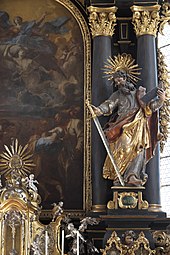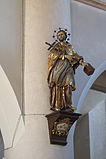Assumption of Mary (Höchstädt on the Danube)
The Catholic town parish church of the Assumption in Blenheim , a town in the district of Dillingen in Bavarian administrative region of Swabia , was built in the 15th century. The church has frescoes from the late Gothic and Renaissance periods . The baroque furnishings from the 17th and 18th centuries have also been preserved. The church is one of the protected architectural monuments in Bavaria.
The church has been renovated since November 2018 and is currently scaffolded. The work should be completed by the 500th consecration anniversary in 2023.
history
A parish church consecrated to “Our Lady” is mentioned in Höchstädt as early as 1321. It was located in what is now called the northern suburb of the old town, which was elevated to the status of a town in the early 13th century under the rule of the Hohenstaufen . The parish church in the old town was demolished in 1557.
In the second half of the 13th century, the Wittelsbachers founded a new town elsewhere, at the foot of the castle , in which a new church was also built. This was initially subordinate to the Steinheim parish as a branch church . Like Steinheim, it belonged to the Reichenbach Monastery and probably only became an independent parish at the beginning of the 14th century. The parish church in the new town is mentioned in a document from 1382.
The originally modest church building was replaced in the 15th century by a much larger new building, which was mainly financed by generous donations from the Höchstädter citizens. The presumed year of consecration of the church was 1523. In 1542 Count Palatine Ottheinrich in Höchstädt, who had come to Palatinate-Neuburg in 1505 , introduced the Reformation . From 1543 to 1634 the parish church was used for Protestant worship. A large part of the original furnishings fell victim to the iconoclasm of the Reformation . From 1576 to 1579 the tower was raised by the octagon . In 1624 Count Palatine Wolfgang Wilhelm restored the Catholic religion and ten years later the church was returned to the Catholics. By 1636 all Protestants had left Höchstädt. The baroque interior, which has been preserved to this day, was created between 1680 and 1760.
The sacristy was added another floor in 1904. At the same time, small external towers were added to the church tower and at the height of the gallery.
architecture
Exterior construction
The bell tower covered with a French dome rises in the northern corner of the choir. The floors of the square substructure are separated from one another by cornices with tracery friezes and serrated ribbons. On the top floor, coupled arched windows open on all four sides . On the east side of the tower there is a small polygonal stair tower with a tent roof .
The west facade has a stepped gable and is broken through by a large tracery window. At the western end of the south side there is a round stair tower with a conical roof that leads to the gallery . The outer walls are structured by strong buttresses , which are provided with pent roofs and partially decorated with clay tracery friezes.
Two pointed arched portals on the north side and two round arched portals on the south side lead into the interior. The right south portal is integrated into an open vestibule with a net vault . The wooden doors of the portals are provided with flat carvings and were created around 1790/1800.
inner space
The interior is designed as a three-aisled relay hall , with the central nave being considerably wider and higher than the two side aisles. The nave is divided into seven bays divided based on the pointed arch arcades and rest columns with Achtecksockeln. Window windows are cut into the nave walls. The main and side aisles have reticulated vaults. One keystone bears a stonemason's mark, while the coats of arms of Höchstädt, Bavaria and the Palatinate are painted on the others .
A pointed arch opens the central nave to the four-bay choir , which is three steps higher . It is illuminated by seven windows and is covered with a star vault, the keystones of which are decorated with the Bavarian coat of arms, a white and blue diamond shield, the imperial eagle, the Palatinate lion and a black cock on a gold background, the coat of arms of the mother parish of Steinheim. The vault ribs protrude from short, semicircular services and rest on figurative consoles . Four represent angels, two a bearded man and a beardless man, all figures hold banners.
Frescoes
The ceiling frescoes in the choir are dated around 1520/30. Three angels with the tools of the Passion are depicted on the three eastern vaulted areas, a lamb with a flag and chalice, Mary in a halo and the coats of arms of Pfalz-Neuburg and Höchstädt are depicted in the middle areas. The fields on the side represent the four church fathers and the evangelist symbols.
The frescoes on the pillars in the nave are dated around 1600. They depict Christ with the globe, two angels with scrollwork cartouches and Joseph telling the brothers his dream.
pulpit
With rich carving, with garlands, friezes and Perlstab provided Pulpit made from oak and basswood is Johann Baptist Libigo attributed, who probably modeled on the pulpit of the parish church in 1681 St. Peter anfertigte in Dillingen. The six-sided body rests on a cup base with lavishly decorated volutes. It is structured by pilasters and shell niches, which are decorated with the wooden sculptures of Christ, Mary and the four evangelists. Two caryatid angels carry the sound cover , at the corners of which winged angel heads are attached like on the tower-like structure. In the upper part there is a figure of Christ in an openwork lantern .
Further equipment
- The high altar dates from 1695. The Assumption of Mary is depicted on the altar panel and the Holy Trinity in the extract . The figures of the apostles Peter and Paul were created by Johann Baptist Libigo. The silver-plated and gold-plated tabernacle from 1759/60 is the work of the sculptor Johann Michael Fischer and the master joiner Johann Eggert.
- The sacrament house was made of sandstone at the end of the 15th century. It is ten meters high and decorated with numerous pinnacles , crabs and finials . An angel and a prophet are depicted under two keel arches , both of whom carry banners. The top is crowned by a pelican, underneath is a wooden figure of St. Barbara , which is also dated to the late 15th century.
- The baptismal font is dated around 1400. It consists of a twelve-sided limestone bowl and is decorated with a clover-leaf frieze. The carving group of the baptism of Jesus comes from more recent times.
- The figures of St. Modestus , St. Sebastian and St. Vitus were made by Johann Baptist Libigo around 1700.
- The sculpture of St. John Nepomuk is a work by Stephan Luidl from 1723.
- The figures of St. Anne and St. Joachim under the gallery are dated around 1760 and ascribed to the sculptor Johann Michael Fischer.
- The choir stalls are marked with the year 1749. It is decorated with flat carvings and is crowned by an openwork top with volutes, shell and latticework.
organ
In 1961 a new organ was installed by the organ building company Sandtner from Dillingen an der Donau .
Epitaphs
There are several epitaphs in the church . The epitaph for the nurse Haug Graf von Montfort († 1536) shows the deceased standing in front of Renaissance architecture, in armor and with his hands folded in prayer. A tournament helmet lies at his feet and a dog crouches next to the Montfort coat of arms. Another epitaph commemorates the court master Regina von Wildenstein († 1621), née Messenbach. It is provided with an inscription and three coats of arms. The coat of arms stone for Friedrich von Grafenegg zu Kaltenbrunn and his wife Dorothea, née Welwart († 1487), is decorated with a crab- adorned keel arch , and a minuscule inscription is carved into the edge . On the tombstone for Anna Barbara Erlbeck from Blindheim , née Pelkoven († 1620), an alliance coat of arms framed by a laurel wreath and four ancestral coats of arms are shown.
Peal
A five-part bell hangs in the tower of the parish church, the deepest bell of the diocese of Augsburg. The bells were cast in 1953 by the bell caster Karl Czudnochowsky (Erding) in a light bell rib with euphone alloy. They have the beat notes g 0 , h 0 , d 1 , e 1 and f sharp 1 .
literature
- Georg Dehio (revised by Bruno Bushart and Georg Paula): Handbuch der deutschen Kunstdenkmäler. Art monuments Bavaria III: Swabia. Deutscher Kunstverlag, Munich 1989, ISBN 3-422-03008-5 , pp. 448–451.
- Werner Meyer (arr.): The art monuments of Bavaria. The art monuments of Swabia. Vol. VII. The art monuments of the district of Dillingen on the Danube. R. Oldenbourg Verlag, Munich 1972, ISBN 3-486-43541-8 , pp. 385-414.
- Julius Schöttl, Werner R. Stirnweiß: Höchstädt / Donau. City parish church of the Assumption. (= Little Art Guide No. 280). 2. completely reworked. Edition, Verlag Schnell and Steiner, Munich / Zurich 1981, ISBN 978-3-7954-4216-3 .
Web links
- Catholic parish church of the Assumption of the Virgin, City of Höchstädt on the Danube
- Church history by year parish community Höchstädt
Individual evidence
- ↑ Höchstädt: Assumption of the Virgin Diocese of Augsburg
- ↑ List of monuments for Höchstädt an der Donau (PDF) at the Bavarian State Office for Monument Preservation, monument number D-7-73-139-36 .
- ^ Anton von Steichele: XI. Land chapter Höchstädt. 6. Höchstädt parish . In: The Diocese of Augsburg, described historically and statistically . Volume: 4. The country chapters: Friedberg, Füssen, Höchstätt, Hohenwart. Augsburg 1883, p. 666.
- ↑ Video recording of the peal
- ↑ Information about the bells
Coordinates: 48 ° 36 ′ 40.7 ″ N , 10 ° 33 ′ 59 ″ E



















